Colorado School of Mines
 | |
| Motto | Nil sine numine (Latin) |
|---|---|
Motto in English | Nothing without God's will |
| Type | Public |
| Established | 1874 |
| Endowment | $286 million (2017)[1] |
| President | Paul C. Johnson |
| Students | 6,117 [2] |
| Undergraduates | 4,757 [2] |
| Postgraduates | 1,286 [2] |
| Location |
Golden, Colorado, U.S. 39°45′4″N 105°13′21″W / 39.75111°N 105.22250°WCoordinates: 39°45′4″N 105°13′21″W / 39.75111°N 105.22250°W |
| Campus | Suburban, 373 acres (1.51 km2) [3] |
| Colors |
Blue & Silver[4] |
| Nickname | Orediggers |
Sporting affiliations | NCAA Division II – Rocky Mountain |
| Mascot |
Marvin the Miner Blaster the Burro[5] |
| Website |
www |
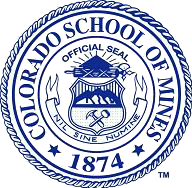 | |
Colorado School of Mines, also referred to as "Mines", is a public teaching and research university in Golden, Colorado, devoted to engineering and applied science, with special expertise[6] in the development and stewardship of the Earth's natural resources. Mines placed 82nd in the 2017 U.S. News & World Report "Best National Universities" ranking. In the 2016–17 QS World University Rankings by subject, the university was ranked as the top institution in the world for mineral and mining engineering.[7]
History
Early history
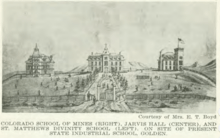
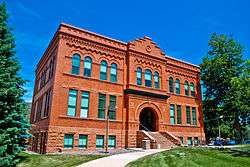
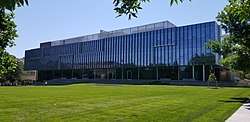
Golden, Colorado, established in 1859 as Golden City, served as a supply center for miners and settlers in the area. In 1866, Bishop George M. Randall of Massachusetts arrived in the territory and, seeing a need for higher education facilities in the area, began planning for a university which would include a school of mines. In 1870, he opened the Jarvis Hall Collegiate School in the central building of the Colorado University Schools campus just south of the town of Golden, accompanied it with Matthews Hall divinity school in 1872, and in 1873 the School of Mines opened under the auspices of the Episcopal Church. In 1874 the School of Mines, supported by the territorial government since efforts began in 1870, was acquired by the territory and has been a state institution since 1876 when Colorado attained statehood. Tuition was originally free to residents of Colorado.[9] The school's logo was designed by prominent architect Jacques Benedict.
The first building on the current site of the school was built in 1880 with additions completed in 1882 and 1890. The building, known as "Chemistry Hall," stood where Hill Hall is now located. The next building to be added to the campus was Engineering Hall, built in 1894, which is still in use today by the Economics and Business Division.
Other firsts include the first Board of Trustees meeting held in 1879; the first formal commencement held in 1883 for two graduates (William Beebe Middleton and Walter Howard Wiley); the first international student graduated in 1889; and the first female student graduated in 1898. In 1906, Mines became the first school of its kind in the world to own and operate its own experimental mine, designed for practical teaching of the students, which was located on Mt. Zion and succeeded in the 1930s by the Edgar Mine. In 1879, there was some discussion about merging School of Mines and the State University in Boulder. Apparently, because of the specialized focus of School of Mines, it was decided that such a merger would not be appropriate. During the early years of the institution, the chief administrator was the "Professor in Charge". The designation "President" was first used in 1880. The "M" on Mt. Zion, a prominent feature in the Golden area, was constructed in 1908 and lighted in 1932.
Early academic departments were drafting, physics, metallurgy, chemistry and mining. In the 1920s, departments formed in geology, petroleum engineering and geophysics. Petroleum refining was added in 1946. The Humanities, Arts and Social Sciences Division (formerly Liberal Arts and International Studies) and the Department of Physical Education and Athletics provide nontechnical educational opportunities for Mines students. Other facilities include: Ben Parker Student Center, Arthur Lakes Library, Green Center and the Edgar Mine which is located in Idaho Springs.
Recent history
The Colorado School of Mines is a public research university devoted to engineering and applied science.
In August 2007, a new student recreation center was completed. In 2008, the school finished expanding its main computer center, the Center for Technology and Learning Media (CTLM). In May 2008 the school completed construction and installation of a new supercomputer nicknamed "Ra"[10] in the CTLM managed by the Golden Energy Computing Organization (GECO), a partnership among the Colorado School of Mines, the National Renewable Energy Laboratory, the National Center for Atmospheric Research and the National Science Foundation.
The school operates the Colorado School of Mines Geology Museum, which displays rock and mineral specimens collected from Colorado's numerous mining districts as well as around the world. The museum's exhibits include specimens from the Frank Allison gold and silver collection, part of the famous Nininger meteorite collection, and Sweet Home Mine rhodochrosite, as well as a model uranium mine and various pieces of mining related art.
Mines is the host of the annual Colorado State Science Olympiad, which draws teams from both the northern regional (hosted at Poudre High School) and southern regional (hosted at the University of Colorado at Colorado Springs) competitions. One or two teams usually advance to the national finals, depending on the number of teams registered to compete. Mines also hosts the Colorado Regional Science Bowl, and shares hosting of the Colorado State MathCounts Competition with University of Denver, alternating biennially.
Since 1964, the Colorado School of Mines has hosted the annual oil shale symposium, one of the most important international oil shale conferences. Although the series of symposia stopped after 1992, the tradition was restored in 2006.[11]
Presidents
- Chris Stell. – 1873[n 1]
- Gregory Board – 1875[n 1]
- Milton Moss – 1878[n 1]
- Albert C. Hale – 1880[n 2]
- Regis Chauvenet – 1883
- Charles S. Palmer – 1902
- Victor C. Alderson – 1903[n 3]
- William G. Haldane – 1913
- William B. Phillips – 1915
- Howard C. Parmelee – 1916
- Victor C. Alderson – 1917[n 3]
- Melville F. Coolbaugh – 1925
- Ben H. Parker – 1946
- John W Vanderwilt – 1950
- Orlo E. Childs – 1963
- Guy T. McBride, Jr. – 1970
- George S. Ansell – 1984
- Theodore A. Bickart – 1998
- John U. Trefny – 2000
- Myles W. Scoggins – 2006
- Paul C. Johnson – 2015
Facilities
The design of the university's buildings have varied widely over time, spanning a spectrum of styles from Second Empire to Postmodernist, created by noted Colorado architectural masters including Robert S. Roeschlaub (Hall of Engineering), Jacques Benedict (Steinhauer Field House), and Temple Hoyne Buell (Berthoud Hall). To date, three main academic buildings are gone (original Territorial School of Mines, 1871–93; Hall of Chemistry, 1880–1958; Paul Meyer Hall, 1963-2016), while the present campus includes:
- Alderson Hall
- Chemical and Biological Engineering
- Berthoud Hall
- Geology and Geological Engineering
- Brown Hall (Building)
- Engineering (Civil, Electrical, Mechanical, undergraduate Environmental)
- Computer Science
- Mining Engineering
- Chauvenet Hall
- Applied Math and Statistics
- Coolbaugh Hall
- Chemistry and Geochemistry
- Environmental Science and Engineering
- CoorsTek Center for Applied Science and Engineering
- Physics
- Center for Technology and Learning Media (CTLM)
- Academic Computing and Networking
- Engineering Hall
- Economics and Business
- General Research Laboratory and Geology Museum
- Green Center
- Geophysics
- GC Office of Events
- Guggenheim Hall
- President's Office
- Administrative Offices
- Hill Hall
- Materials Science
- Metallurgical and Materials Engineering
- Arthur Lakes Library
- Library
- Marquez Hall
- Petroleum Engineering
- Moly Building
- Colorado Geological Survey
- Recreation Center
- Starzer Welcome Center
- Admissions
- Colorado School of Mines Alumni Association
- Colorado School of Mines Foundation
- Stratton Hall
- Humanities, Arts and Social Sciences
- Applied Math and Statistics (not primary location)
- Steinhauer Field House
- Student Center
- Financial Aid
- Bookstore
- Registrar
- Student Life
- Student Health Center
- U.S Geological Survey
- National Earthquake Information Center
- National Landslide Information Center
- Volk Gymnasium
- Physical Education and Athletics
Major open-air athletic facilities of the Colorado School of Mines include historic Campbell Field and Darden Field.
The honorary named Colorado School of Mines buildings commemorate Dr. Victor C. Alderson, Edward L. Berthoud, George R. Brown, Dr. Regis Chauvenet, Dr. Melville F. Coolbaugh, Cecil H. and Ida Green, Simon Guggenheim, Nathaniel P. Hill, Arthur Lakes, Dr. Paul D. Meyer, Winfield S. Stratton, and Russell K. Volk.
Academics
Mines is organized around three Colleges:
- College of Applied Science and Engineering (CASE)
- College of Engineering and Computational Sciences (CECS)
- College of Earth Resource Sciences and Engineering (CERSE)
Mines began the world's first graduate program in space resources in the fall semester of 2018, offering both master's and PhD degrees.[12]
Rankings
| University rankings | |
|---|---|
| National | |
| U.S. News & World Report[13] | 88 |
| Washington Monthly[14] | 153[15] |
- 1st in "USA Today's Top 10 Engineering Schools 2015".[16]
- 1st in Mining Engineering, Top Universities [17]
- 5th in Petroleum Engineering, U.S. News & World Report's 2017 Best Engineering Graduate Schools[18]
- 20th in Nuclear Engineering, U.S. News & World Report's 2017 Best Engineering Graduate Schools[19]
- 38th in U.S. News & World Report's 2015 "Top Public Schools".[20]
- 35th in U.S. News & World Report's 2015 "Best Engineering Graduate Schools".
- 88th in U.S. News & World Report's 2017 "Best National Universities Rankings".
- 139th in Times Higher Education's 2014 "World University Rankings".
- 82/76th in Kiplinger's Personal Finance magazine’s 2014 "Best Values in Public Colleges."[21]
Admissions profile
For freshmen entering Fall 2014, Colorado School of Mines received 12,340 applications, accepted 4,501 (36.5%) and enrolled 999 (22.2% of those accepted).[22] The middle 50% range of SAT scores for the enrolled freshmen was 590–680 for critical reading, 640–720 for math, and 560–650 for writing, while the ACT Composite range was 28–32.[22] The average GPA was 3.80. Men constituted 73.8% of the incoming class, women 26.2%.[22]
Traditions
E-Days
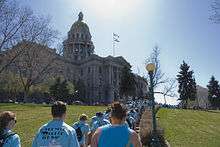
Each spring semester, the Colorado School of Mines students and faculty celebrate E-days (or Engineering Days). This three-day festival is kicked off Friday morning with the "Ore Cart Pull". This event consists of students collectively pulling an ore cart 7.5 miles down Colfax Ave to the Colorado State Capitol in Civic Center Park. Other attractions of this event include a cardboard boat race down nearby Clear Creek, a concert featuring a community-voted artist, and a large fireworks show Saturday night to end the festival, among many other small campus-hosted events.
M-Climb
Freshmen at the Colorado School of Mines are expected, but not required, to participate in the M-Climb. During this climb, students carry a ten-pound rock brought from their hometown up Mt. Zion. At the top of the mountain, they are then told to whitewash the M. While also being a mild hazing tradition, students take great pride in this process as it symbolizes the struggle they endure at the school to reach their goals. At graduation time, seniors are invited to return to the M and retrieve a rock to keep. This symbolizes the students taking the knowledge and skills they've learned with them into the next stage of their lives.
Athletics
The Colorado School of Mines' intercollegiate sports teams are known as the Orediggers. The Orediggers compete as members of NCAA Division II and the Rocky Mountain Athletic Conference for all 18 varsity sports. The Oredigger athletic teams include baseball, football, wrestling, men's and women's basketball, men's and women's cross country, men's golf, men's and women's soccer, softball, men's and women's swimming and diving, men's and women's indoor/outdoor track and field, and women's volleyball.
Notable alumni
- Tesho Akindele, Canadian soccer player for FC Dallas in Major League Soccer, 2014 MLS Rookie of the Year.
- Arden L. Bement, Jr., Director of the National Science Foundation 2004–2010.[23]
- Blake Carrington [(John Forsythe) fictional], oil magnate, head of the Denver-Carrington corporation in the ABC TV series Dynasty
- Shane Carwin (mechanical engineering), wrestler; former mixed martial artist who won the UFC Interim Heavyweight Championship.[24]
- Antônio Ermírio de Moraes, Brazilian businessman, chairman of the Votorantim Group, and ranked one of the richest men in Brazil by Forbes magazine.
- Wendell Fertig, civil engineer and World War II hero.
- Jan Miller, metallurgical engineer and member of the National Academy of Engineering
- Roger Rueff, dramatist, B.Sc. 1978, M.Sc. '83 and Ph.D. '85 in Chemical and Petroleum Refining Engineering.
- George Saunders, writer, journalist and college professor, B.Sc. 1981 in Geophysical Engineering.
- Marc Schiechl, NFL Jacksonville Jaguars, AFL LA Kiss.
- Sao Kya Seng, mining engineer, politician, agriculturalist and the last saopha of Hsipaw State, Myanmar.
- Robert H. Waterman Jr., co-author of In Search of Excellence, Geophysical Engineer 1958, Medalist '84.
See also
References
Notes
- ↑ As of June 2017. "Mines By The Numbers". Colorado School of Mines.
- 1 2 3 As of Fall 2017. "Mines By The Numbers". Colorado School of Mines.
- ↑ "Mines By The Numbers". Colorado School of Mines.
- ↑ Mines Graphic Standards Guide (PDF). Archived from the original (PDF) on 2015-10-10. Retrieved 2016-09-14.
- ↑ Blaster – Burro or Mule? Archived April 20, 2008, at the Wayback Machine.
- ↑ "Colorado School of Mines – Best Colleges – Education – US News and World Report". Colleges.usnews.rankingsandreviews.com. 2009-08-19. Archived from the original on 2009-02-27. Retrieved 2009-10-08.
- ↑ "QS World University Rankings by Subject 2016 - Engineering - Mineral & Mining". Top Universities. QS Quacquarelli Symonds. Retrieved 14 September 2016.
- ↑ "Alderson Hall". Jefferson County Place Names Directory. Retrieved 2 October 2016.
- ↑ Thomas, Grace Powers (1898). Where to educate, 1898–1899. A guide to the best private schools, higher institutions of learning, etc., in the United States. Boston: Brown and Company. p. 23. Retrieved August 17, 2012.
- ↑ Mines unveils energy supercomputer 'Ra' Archived May 16, 2008, at the Wayback Machine.
- ↑ Purga, Jaanus (2006). "26th Oil Shale Symposium in Golden – waking up the largest oil shale reserve in the world" (PDF). Oil Shale. A Scientific-Technical Journal. Estonian Academy Publishers. 23 (4): 385–386. ISSN 0208-189X. Retrieved 2009-07-09.
- ↑ School Of Mines Debuts The world's first degree program for space mining, Colorado Public Radio, 13 August 2018, accessed 17 August 2018.
- ↑ "Best Colleges 2017: National Universities Rankings". U.S. News & World Report. September 12, 2016.
- ↑ "2016 Rankings - National Universities". Washington Monthly. Retrieved September 6, 2016.
- ↑ "2014 National Universities Rankings". Washington Monthly. n.d. Archived from the original on 2014-08-28. Retrieved May 27, 2015.
- ↑ "The top 10 engineering colleges in the U.S." College.usatoday.com. Retrieved 26 May 2017.
- ↑ "New Ranking of the World's Top Mining Engineering Schools". 21 March 2016. Retrieved 26 May 2017.
- ↑ "Best Graduate Petroleum Engineering Programs". Usnews.com. Retrieved 7 August 2018.
- ↑ "Best Graduate Petroleum Engineering Programs". Usnews.com. Retrieved 7 August 2018.
- ↑ "Colorado School of Mines." Archived 2013-03-07 at the Wayback Machine. U.S. News & World Report. 2014
- ↑ "Best Values in Public Colleges". Kiplinger's Personal Finance. January 2013.
- 1 2 3 "Colorado School of Mines Common Data Set 2014–2015, Part C" (PDF). Colorado School of Mines.
- ↑ "US NSF - Office of the Director - List of NSF Directors, 1950-present". Nsf.gov. Retrieved 26 May 2017.
- ↑ "Shane Carwin UFC Bio". Ufc.com. Retrieved 2014-01-01.